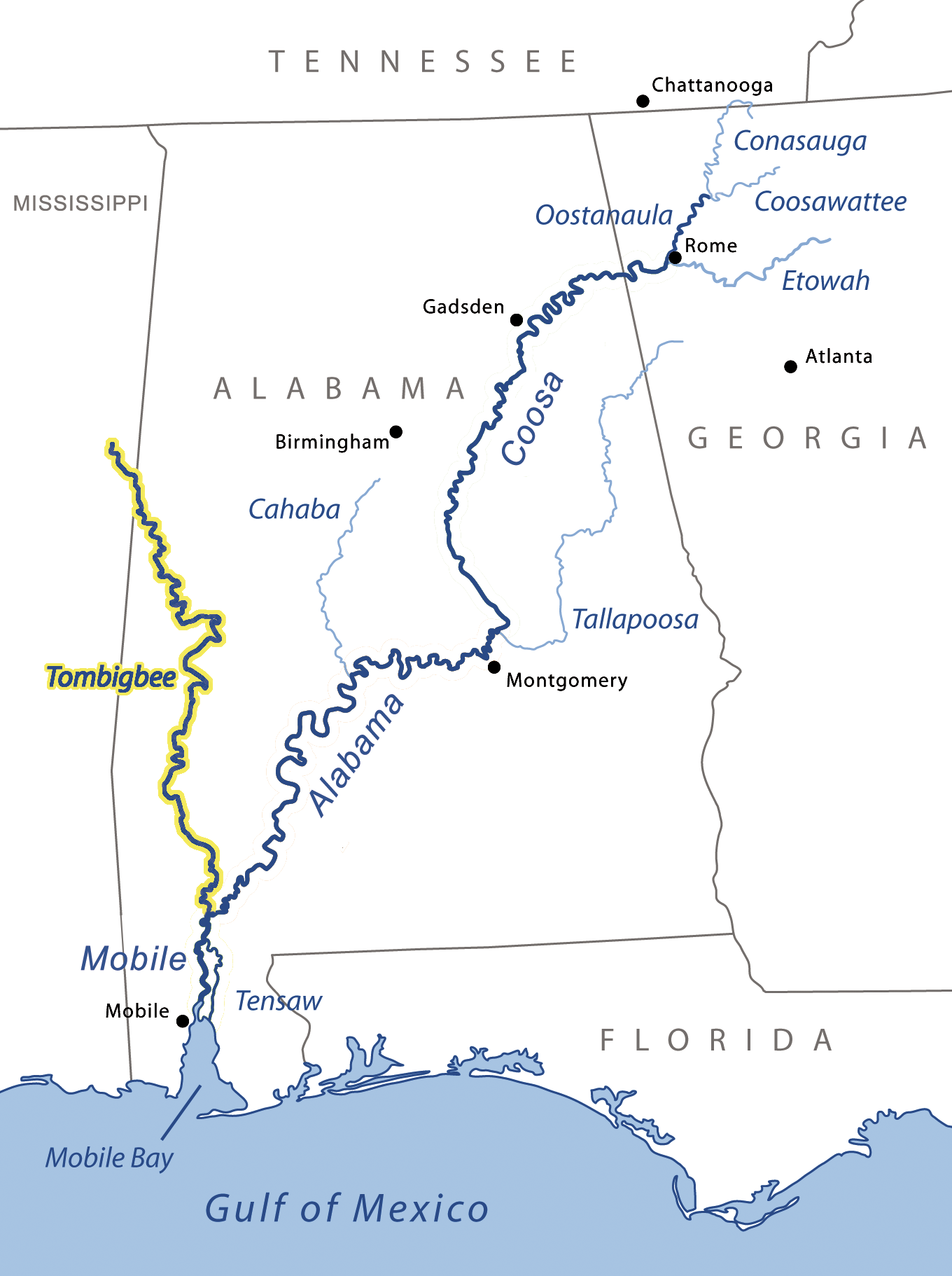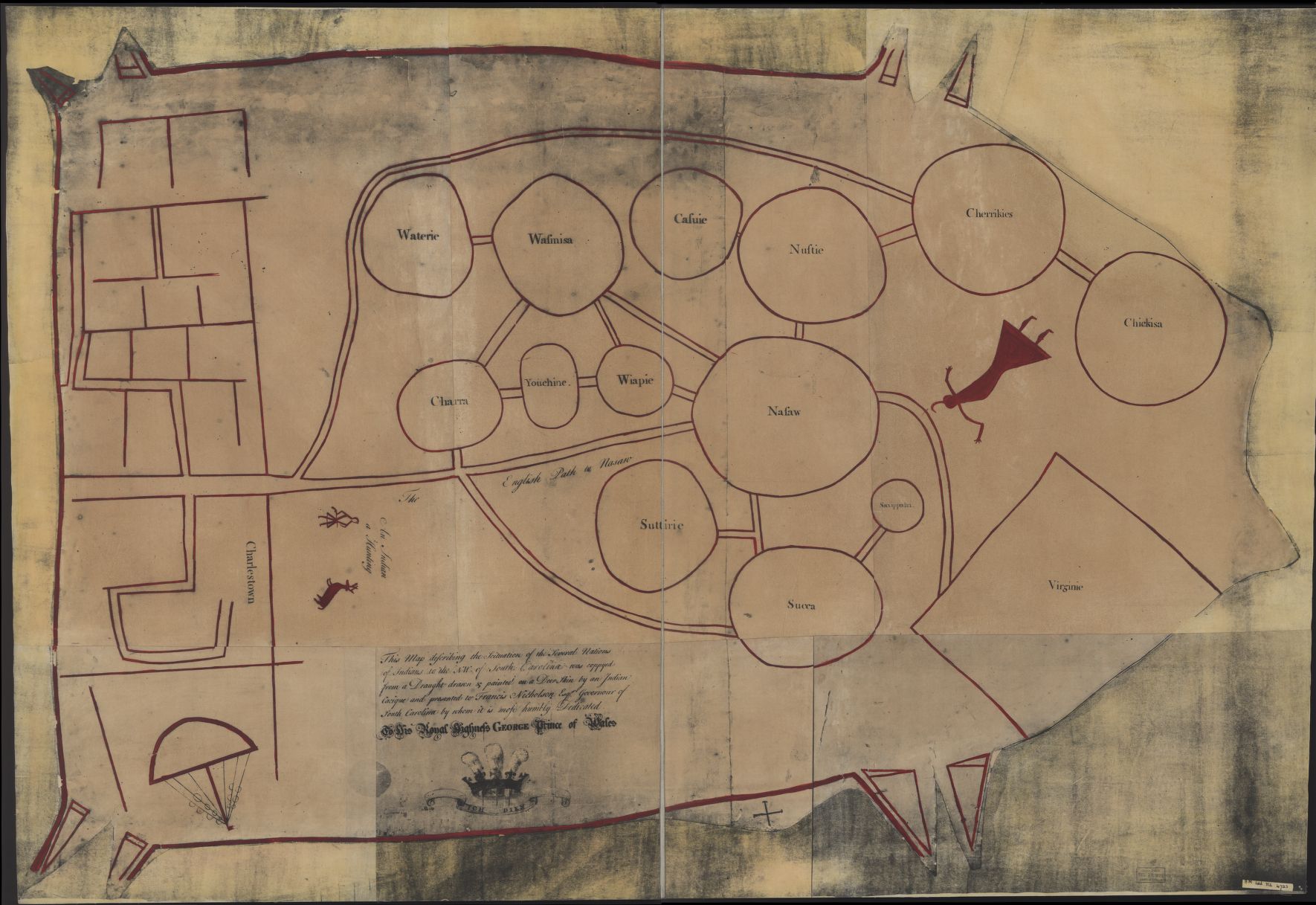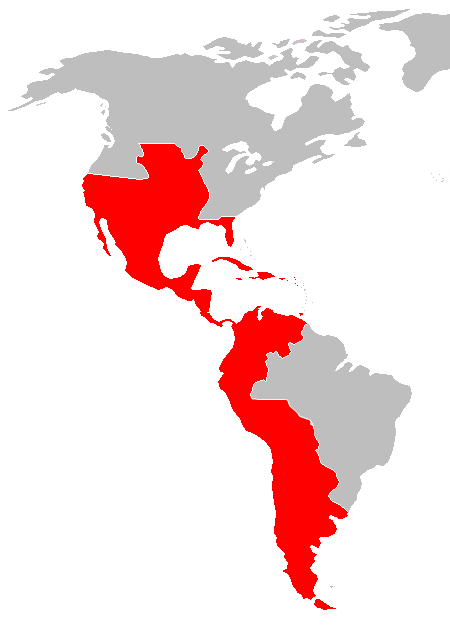|
Simon Favre
Simon Favre (May 31, 1760 – July 3, 1813) was an interpreter of the Muskogean languages, particularly Choctaw and Chickasaw, for the French, British, Spanish and Americans in the part of West Florida that became part of the states of Mississippi and Alabama. The son of another prominent interpreter, Favre spent the late 18th century in the vicinity of Mobile and the Tombigbee River, which changed hands from French to British, and then Spanish control. He became well versed in the language and culture of the Choctaws, and was involved with several treaties between the Europeans and natives. As a young man he had a Choctaw mistress with whom he had six known children, then at the age of 41 he was legally married in Mobile to a woman of European descent. Within a few years of his marriage, he moved with his new family from the Tombigbee area to a plantation on the Pearl River. As the power of the Choctaws diminished, Favre became less important as an interpreter, and more im ... [...More Info...] [...Related Items...] OR: [Wikipedia] [Google] [Baidu] |
Louisiana (New France)
Louisiana (french: La Louisiane; ''La Louisiane Française'') or French Louisiana was an administrative district of New France. Under French control from 1682 to 1769 and 1801 (nominally) to 1803, the area was named in honor of King Louis XIV, by French explorer René-Robert Cavelier, Sieur de la Salle. It originally covered an expansive territory that included most of the drainage basin of the Mississippi River and stretched from the Great Lakes to the Gulf of Mexico and from the Appalachian Mountains to the Rocky Mountains. Louisiana included two regions, now known as Upper Louisiana (), which began north of the Arkansas River, and ''Lower Louisiana'' (). The U.S. state of Louisiana is named for the historical region, although it is only a small part of the vast lands claimed by France.La Louisiane française 1682-1803 ... [...More Info...] [...Related Items...] OR: [Wikipedia] [Google] [Baidu] |
Pierre Le Moyne D'Iberville
Pierre Le Moyne d'Iberville (16 July 1661 – 9 July 1706) or Sieur d'Iberville was a French soldier, explorer, colonial administrator, and trader. He is noted for founding the colony of Louisiana in New France. He was born in Montreal to French colonist parents. Early life Pierre Le Moyne was born in July 1661 at Fort Ville-Marie (now Montreal), in the French colony of Canada, the third son of Charles le Moyne de Longueuil et de Châteauguay, a native of Dieppe or of Longueuil near Dieppe, Normandy in France and lord of Longueuil in Canada, and of (called Catherine Primot in some sources) from Rouen. He is also known as ''Sieur d'Iberville'' (''et d'Ardillières''). He had eleven brothers, most of whom became soldiers. One, Jacques Le Moyne de Sainte-Hélène, led French and Indian forces in the Schenectady massacre in present-day New York's Mohawk Valley. Charles le Moyne de Longueuil, Baron de Longueuil, was governor of Montreal. Another, Jean-Baptiste Le Moyne Bienville, ... [...More Info...] [...Related Items...] OR: [Wikipedia] [Google] [Baidu] |
Yazoo River
The Yazoo River is a river in the U.S. states of Louisiana and Mississippi. It is considered by some to mark the southern boundary of what is called the Mississippi Delta, a broad floodplain that was cultivated for cotton plantations before the American Civil War. It has continued to be devoted to large-scale agriculture. History The Yazoo River was named by French explorer La Salle in 1682 as "Rivière des Yazous" in reference to the Yazoo tribe living near the river's mouth at its confluence with the Mississippi. The exact meaning of the term is unclear. One long held belief is that it means "river of death". The river is 188 miles (303 km) long and is formed by the confluence of the Tallahatchie and the Yalobusha rivers, where present-day Greenwood developed. The river parallels the Mississippi River in the latter's floodplain for some distance before joining it north of Vicksburg, Mississippi. Natural levees which flank the Mississippi prevent the Yazoo from joini ... [...More Info...] [...Related Items...] OR: [Wikipedia] [Google] [Baidu] |
Francisco Luis Héctor De Carondelet
Francisco Luis Héctor de Carondelet y Bosoist, 5th Baron of Carondelet, (born 1748, Noyelles-sur-Selle, County of Flanders, Flanders – died 1807 Quito, Ecuador) was a Spanish administrator of partial Burgundy, Burgundian descent in the employ of the Spanish Empire. He was a Knights Hospitaller, Knight of Malta. Biography Youth and military career Carondelet entered the service of the King of Spain in 1762, at age fifteen. By 1781, he commanded the IV Division, which fought at the Siege of Pensacola in 1781. Upon his return to Spain in 1787, he was attached to the Flandres Regimiento, with the rank of Infantry Colonel, and was received in the Order of Malta. During this period he married, against his own family's will, a woman from Aragón whose family was very influential at the royal court, Maria Concepción Castaños y Aragorri. Governor of El Salvador (1789 – 1791) Carondelet was named governor of El Salvador in 1789. Because the local Indigenous peoples of the Amer ... [...More Info...] [...Related Items...] OR: [Wikipedia] [Google] [Baidu] |
Thomas Hinds
Thomas Hinds (January 9, 1780August 23, 1840) was an American soldier and politician from the state of Mississippi, who served in the United States Congress from 1828 to 1831. A hero of the War of 1812, Hinds is best known today as the namesake of Hinds County. Biography Early years Thomas Hinds was born in Berkeley County, Virginia, (now part of West Virginia), on January 9, 1780. He would later move to (Old) Greenville in Jefferson County, Mississippi, where he was appointed justice and assessor of the county in 1805.Dunbar Rowland, "Thomas Hinds," i''Mississippi: Comprising Sketches of Counties, Towns, Events, Institutions and Persons - Volume 1.''Atlanta, GA: Southern Historical Publishing Association, 1907; pp. 870-871. Hinds was made a member of the Mississippi Territorial Council in 1806, remaining in that position until 1808. Military career Hinds was commissioned as a cavalry lieutenant in October 1805, gaining promotion to major in September 1813, during the Wa ... [...More Info...] [...Related Items...] OR: [Wikipedia] [Google] [Baidu] |
Andrew Jackson
Andrew Jackson (March 15, 1767 – June 8, 1845) was an American lawyer, planter, general, and statesman who served as the seventh president of the United States from 1829 to 1837. Before being elected to the presidency, he gained fame as a general in the United States Army and served in both houses of the U.S. Congress. Although often praised as an advocate for ordinary Americans and for his work in preserving the union of states, Jackson has also been criticized for his racial policies, particularly his treatment of Native Americans. Jackson was born in the colonial Carolinas before the American Revolutionary War. He became a frontier lawyer and married Rachel Donelson Robards. He served briefly in the United States House of Representatives and the United States Senate, representing Tennessee. After resigning, he served as a justice on the Tennessee Supreme Court from 1798 until 1804. Jackson purchased a property later known as the Hermitage, becoming a wealthy plan ... [...More Info...] [...Related Items...] OR: [Wikipedia] [Google] [Baidu] |
Pushmataha
Pushmataha (c. 1764 – December 24, 1824; also spelled Pooshawattaha, Pooshamallaha, or Poosha Matthaw), the "Indian General", was one of the three regional chiefs of the major divisions of the Choctaw in the 19th century. Many historians considered him the "greatest of all Choctaw chiefs". Pushmataha was highly regarded among Native Americans, Europeans, and white Americans, for his skill and cunning in both war and diplomacy. Rejecting the offers of alliance and reconquest proffered by Tecumseh, Pushmataha led the Choctaw to fight on the side of the United States in the War of 1812. He negotiated several treaties with the United States. In 1824, he traveled to Washington to petition the Federal government against further cessions of Choctaw land; he met with John C. Calhoun and Marquis de Lafayette, and his portrait was painted by Charles Bird King. He died in the capital city and was buried with full military honors in the Congressional Cemetery in Washington, D.C. Name T ... [...More Info...] [...Related Items...] OR: [Wikipedia] [Google] [Baidu] |
Holmes Colbert
Holmes Colbert was a 19th-century leader of the Chickasaw Nation in Indian Territory (now Oklahoma). Of mixed European and Chickasaw ancestry, Colbert was born to his mother's Chickasaw clan and gained significance in the tribe's history through his family's privileged mixed-race status. Educated in an American school, he knew of both European-American and Chickasaw cultures and contributed to his clan as a mediator between both worlds. He helped write the Chickasaw Nation's constitution in the 1850s after its removal to Indian Territory and reorganization of its government. After the American Civil War, Colbert then went on to serve as the tribe's delegate. Early life and education Holmes Colbert was the son of James Isaac Colbert and Sarah "Sally" McLish. His father James Isaac Colbert, the son of Maj. James Holmes Colbert, already had some remote Chickasaw blood since he was the grandson of James Logan Colbert, a Scots trader from North Carolina who settled in Chickasaw cou ... [...More Info...] [...Related Items...] OR: [Wikipedia] [Google] [Baidu] |
Chickasaw
The Chickasaw ( ) are an indigenous people of the Southeastern Woodlands. Their traditional territory was in the Southeastern United States of Mississippi, Alabama, and Tennessee as well in southwestern Kentucky. Their language is classified as a member of the Muskogean language family. In the present day, they are organized as the Federally recognized tribe, federally recognized Chickasaw Nation. Chickasaw people have a migration story in which they moved from a land west of the Mississippi River, where they settled mostly in present-day northeast Mississippi, northwest Alabama, and into Lawrence County, Tennessee. They had interaction with French, English, and Spanish colonists during the Colonial history of the United States, colonial period. The United States considered the Chickasaw one of the Five Civilized Tribes of the Southeast, as they adopted numerous practices of European Americans. Resisting European-American settlers encroaching on their territory, they were force ... [...More Info...] [...Related Items...] OR: [Wikipedia] [Google] [Baidu] |
Pearl River (Mississippi–Louisiana)
The Pearl River is a river in the U.S. states of Mississippi and Louisiana. It forms in Neshoba County, Mississippi from the confluence of Nanih Waiya and Tallahaga creeks, and has a meander length of .U.S. Geological Survey. National Hydrography Dataset high-resolution flowline dataThe National Map accessed June 13, 2011 The lower part of the river forms part of the boundary between Mississippi and Louisiana. The river watershed contains large areas of bottomland hardwood swamp and cypress swamp, providing habitat for many species of wildlife, including sturgeon and black bears. As recently as 2008, endangered ivory-billed woodpeckers were reportedly sighted here. The mouth of the river creates important marsh habitat along salinity gradients, which has been the subject of many scientific studies. It is considered to be one of the most critical areas of natural habitat remaining in Louisiana. Mississippi's capital and largest city, Jackson, is located along the upper reaches of ... [...More Info...] [...Related Items...] OR: [Wikipedia] [Google] [Baidu] |
Peace Of Paris (1783)
The Peace of Paris of 1783 was the set of treaties that ended the American Revolutionary War. On 3 September 1783, representatives of King George III of Great Britain signed a treaty in Paris with representatives of the United States of America—commonly known as the Treaty of Paris (1783)—and two treaties at Versailles with representatives of King Louis XVI of France and King Charles III of Spain—commonly known as the Treaties of Versailles (1783). The previous day, a preliminary treaty had been signed with representatives of the States General of the Dutch Republic, but the final treaty which ended the Fourth Anglo-Dutch War was not signed until 20 May 1784; for convenience, however, it is included in the summaries below. The treaty dictated that the British would lose their Thirteen Colonies and marked the end of the First British Empire. The United States gained more than it expected, thanks to the award of western territory. The other Allies had mixed to poor results. ... [...More Info...] [...Related Items...] OR: [Wikipedia] [Google] [Baidu] |






